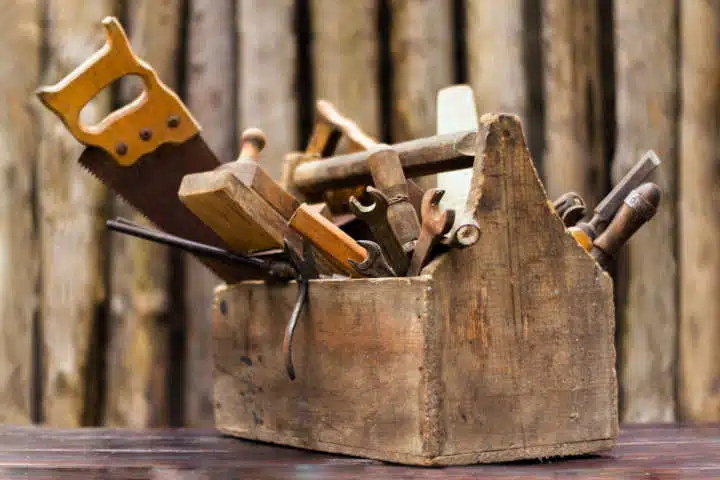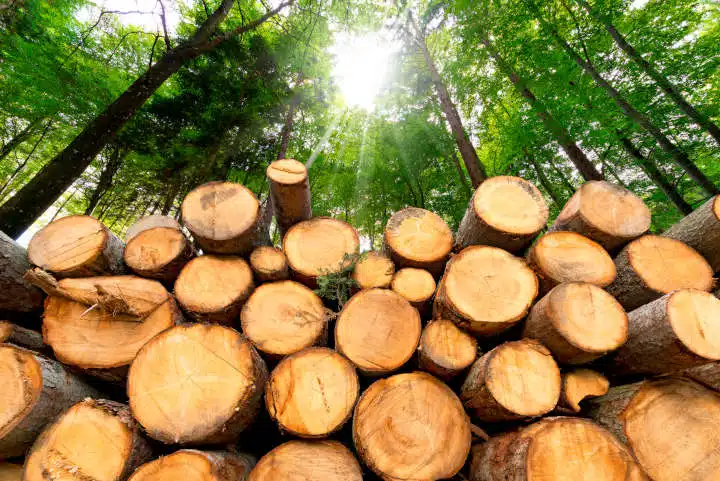A bushcraft cabin is a perfect way to have a base camp in the woods. Whether you are bugging out or just want to get away from it all for a while, a cabin can provide you with shelter, security, and comfort.
Building one does not have to be complicated or expensive. This post will show you how to build one that is simple but sturdy and will serve you well in any situation.
Why Build a Bushcraft Cabin?
There are many benefits to building a shelter of this type. For some, it’s a hobby, and for others, a resource. Below we highlight some of the reasons a person may decide to build.
Enhanced Safety and Security
Building a bushcraft cabin enhances safety and security by providing shelter away from civilization. It provides a safe haven for those who want to live off the grid, away from potential threats such as natural disasters or man-made disasters such as terrorist attacks.
This type of shelter also provides protection against wildlife, as it creates a barrier between humans and wild animals.
Outdoor Recreation and Fun
Building a bushcraft cabin is a great way to enjoy the outdoors and reconnect with nature. It offers many benefits, including providing shelter and comfort, enabling you to spend more time in nature, giving you an opportunity to learn survival skills, and allowing you to create memorable experiences with family and friends.
Moreover, it allows you to view wildlife in its natural habitat up close while also providing protection from harsh weather conditions.
Increased Self-Reliance and Dependability
Building a bushcraft cabin increases self-reliance and dependability by providing a place to live independent of modern technology. It allows people to become more self-sufficient by providing them with the resources they need to survive, such as shelter, food, and water.
Additionally, it helps build confidence and teaches valuable skills you can use in any situation.
Requirements For Building a Bushcraft Cabin
Before getting started on your project, taking inventory of the various elements needed to complete the project is essential.
Skills and Tools Needed

To get started, you will need the following skills and tools:
- Basic carpentry skills – understanding how to use tools such as a hammer, saw, nails, and wood glue
- Knowledge of construction techniques – such as framing walls, installing windows and doors, laying floorboards, etc.
- Ability to use power tools such as drills and chainsaws if necessary
- If you are building in an area with no electricity access, you will need some kind of generator or fuel-powered generator for lighting, etc.
Budget
Before you set out to create your cabin, you must first establish what your budget is for the entire project. Having a set amount in mind will help guide your other decisions.
Design
When designing a bushcraft cabin, there are several considerations to keep in mind. These styles vary from a log cabin and include:
- Location: Choose an appropriate location away from civilization and potential hazards such as flooding or wildfire
- Size: The cabin should be large enough to accommodate all occupants comfortably but small enough so it can be heated efficiently using wood-burning stoves or fireplaces
Required Construction Materials
The required construction materials for building a bushcraft cabin include:
- Logs
- Lashings
- Mud and Chinking Material
- Saw
- Ax or Hatchet
- Winch or Pulley System
- Measuring Tape
How To Build a Bushcraft Cabin Survival Shelter in the Woods
There are several steps to take when building a basic survival shelter in the woods. We outline the basic elements below.
Step 1: Choose Your Site
When choosing a site for a basic survival shelter in the woods, it is essential to consider spatial information (such as distance from water, cover, and materials) and natural elements (such as temperature and wind).
You should choose a site close to the water with plenty of natural coverage and not near dead-standing trees. You should also make sure it’s far enough from the main roads and cities.
You should also consider temperature variations year-round due to hills or valleys in the area:
- windy conditions at the top of hills
- glens that trap cold air
- poisonous plants nearby
- dead or falling trees around your proposed site
- rising and setting of the sun
Step 2: Assess Your Needs
When thinking about what you want out of your shelter, consider all aspects. Make sure that there is enough space inside your shelter for you to lie down comfortably without hitting any walls or objects while still having enough room left over for other activities like cooking food or storing supplies if needed.
Step 3: Gather the Materials Required
To build a basic survival shelter in the woods, you will need the following materials in addition to tools:
- Logs, trees, and branches for building the shelter itself
- Leaves, hay, and bushes to create insulation and bedding
- Stones for the fireplace (enough to form a circle around it)
Step 4: Cut the Logs
The next step is to cut the logs and begin to assemble your shelter.
- Cut two long logs and lay them on the ground parallel to each other, about one foot apart
- Stack shorter logs on long logs to create a triangular shape, using notches to keep them in place
- Connect the gable walls using two purlin logs (longer than the rest)
- Continue stacking up the gable walls until they reach the desired height, then use a ridge log (longest log) to connect them at either end of the triangle shape you’ve created
- Use smaller diameter logs for caulking between the larger ones and for creating a roof rafter system over the top of your shelter’s walls

Step 5: Lay the Roof
When it comes to the roof of your shelter, you want to ensure all logs fit together perfectly.
- Lay small logs vertically to form the roof
- Create notches to keep them close
- Attach lashings and make a triangular shape with two gable walls on each side of the cabin
- Connect walls again using another log (the ridge log) and smaller logs for rafters
- Notch each one with leaves, moss, or clay caulking between logs for insulation purposes and to keep it in place
Tips for Making Your Bushcraft Cabin Comfortable and Safe
When you are spending time in your cabin, you want it to be comfortable and have a few items that make your time easier and enjoyable.
Build the Cabin Tall Enough To Stand Up In
It is essential to build a bushcraft cabin tall enough to stand in for several reasons. First, having it high enough ensures that it will be comfortable and spacious.
Additionally, being able to stand up while inside allows you more flexibility when it comes to activities like cooking or working on projects. Finally, having a high enough cabin also provides greater insulation from the elements since there will be fewer gaps between the logs which need caulking with leaves or moss.
Make the Cabin Wide Enough To Accommodate a Fire, Supplies, and Sleeping Area
It is vital to keep the openings of your bushcraft cabin as small as possible to limit airflow and reduce drafts. To ensure you have enough space for firewood, supplies, and a sleeping area, cut out an opening large enough to crawl through at about waist height or higher. Make sure it’s wide enough so that there is minimal airflow into the cabin.
Make Sure the Cabin Has a Door and Windows for Ventilation
Having adequate ventilation is essential when building a bushcraft cabin. Make sure to include at least one window and door to allow fresh air to circulate. If you are going to be using a wood-burning stove, ensure the chimney has adequate ventilation.
Make Sure the Cabin Has a Stable Foundation
Having a stable foundation for a bushcraft cabin is crucial because it will ensure that the cabin is safe and structurally sound. If the foundation is not stable, it could cause subsidence or other structural issues, potentially leading to safety hazards or damage to your cabin.
Additionally, a solid foundation will help ensure that your cabin lasts for years.
FAQs
To help alleviate any concerns you may have about building a bushcraft cabin, we’ve compiled a list of frequently asked questions.
Is it cheaper to build your own cabin?
The answer to this question depends on a number of factors, including the cost of materials and the amount of time you are willing to spend building your cabin. If you can source all of the materials for your cabin yourself, it is certainly possible to create a cabin for less than the cost of buying one.
However, if you need to purchase all the materials and hire someone to build the cabin for you, then it is unlikely that you will be able to make a cabin for less than the cost of buying one.
What is the simplest cabin to build?
The simplest cabin to build is a bushcraft cabin. These shelters are small, one-room shelters that people typically place in remote areas. You can construct them from a variety of materials, but the most common are logs, branches, and leaves. These designs typically have a dirt floor and no windows or doors.
Can you build a cabin in the woods?
It is possible to build a survival shelter in the woods. However, it’s crucial to understand the materials and tools you’ll need before starting your project. Additionally, it’s a good idea to have a plan in place so that you know what you’re doing before you start building.
How do you make a permanent shelter in the woods?
To make a permanent shelter in the woods, you will first need to find a suitable location for your cabin. It should be in a spot that is sheltered from the wind and has access to water. Once you have found a good site, clear an area for your cabin and build a foundation using logs or rocks.
Building the walls of your cabin is the next step. You can use logs, bark, or stone to create walls that are at least two feet thick. Make sure to build a door and windows that you can cover with animal skins or other materials to keep the cold out.
Once you construct your walls, you can add a roof and a floor to your cabin. A dirt floor is the easiest to make, but you can also use logs or stone.
What is the cheapest foundation for a cabin?
The cheapest foundation for a cabin is typically a gravel pad or slab. This type of foundation is easy to install and very inexpensive.
Do you need permission to build a cabin?
Knowing if you need permission to build a cabin will boil down to the laws of your specific state or country.
Conclusion
Building a bushcraft cabin is a great way to become more self-reliant and independent. With this guide, you’ll learn everything you need to know in order to build your own shelter in the woods. So what are you waiting for? Get started on yours today!




